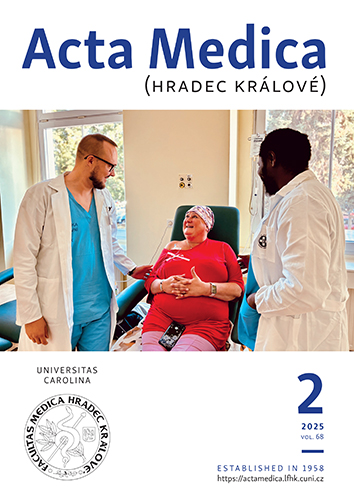ACTA MEDICA, Vol 59 No 3 (2016), 84–90
Risk Factors of Acute Pancreatitis in Oral Double Balloon Enteroscop
Marcela Kopáčová, Jan Bureš, Stanislav Rejchrt, Jaroslava Vávrová, Jolana Bártová, Tomáš Soukup, Jan Tomš, Ilja Tachecí
DOI: https://doi.org/10.14712/18059694.2016.95
published online: 01. 09. 2016
abstract
Double balloon enteroscopy (DBE) was introduced 15 years ago. The complications of diagnostic DBE are rare, acute pancreatitis is most redoubtable one (incidence about 0.3%). Hyperamylasemia after DBE seems to be a rather common condition respectively. The most probable cause seems to be a mechanical straining of the pancreas. We tried to identify patients in a higher risk of acute pancreatitis after DBE. We investigated several laboratory markers before and after DBE (serum cathepsin B, lactoferrin, E-selectin, SPINK 1, procalcitonin, S100 proteins, alfa-1-antitrypsin, hs-CRP, malondialdehyde, serum and urine amylase and serum lipase). Serum amylase and lipase rose significantly with the maximum 4 hours after DBE. Serum cathepsin and procalcitonin decreased significantly 4 hours after DBE compared to healthy controls and patients values before DBE. Either serum amylase or lipase 4 hours after DBE did not correlate with any markers before DBE. There was a trend for an association between the number of push-and-pull cycles and procalcitonin and urine amylase 4 hours after DBE; between procalcitonin and alfa-1-antitrypsin, cathepsin and hs-CRP; and between E-selectin and malondialdehyde 4 hours after DBE. We found no laboratory markers determinative in advance those patients in a higher risk of acute pancreatitis after DBE.
keywords: Acute pancreatitis; Deep enteroscopy; Device assisted endoscopy; Double balloon enteroscopy; Hyperamylasemia; Small intestinal disorders

Risk Factors of Acute Pancreatitis in Oral Double Balloon Enteroscop is licensed under a Creative Commons Attribution 4.0 International License.
210 x 297 mm
periodicity: 4 x per year
print price: 150 czk
ISSN: 1211-4286
E-ISSN: 1805-9694
